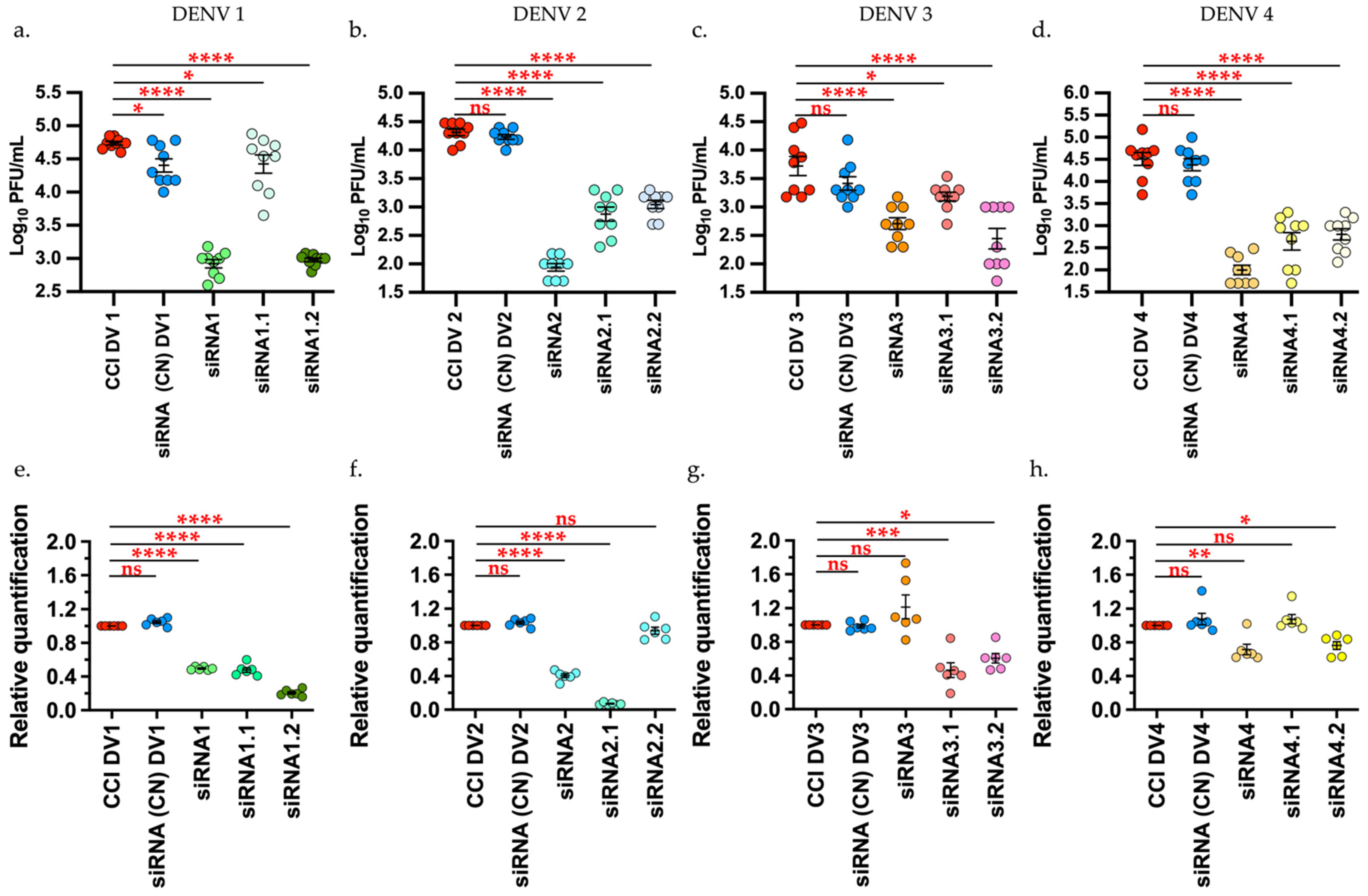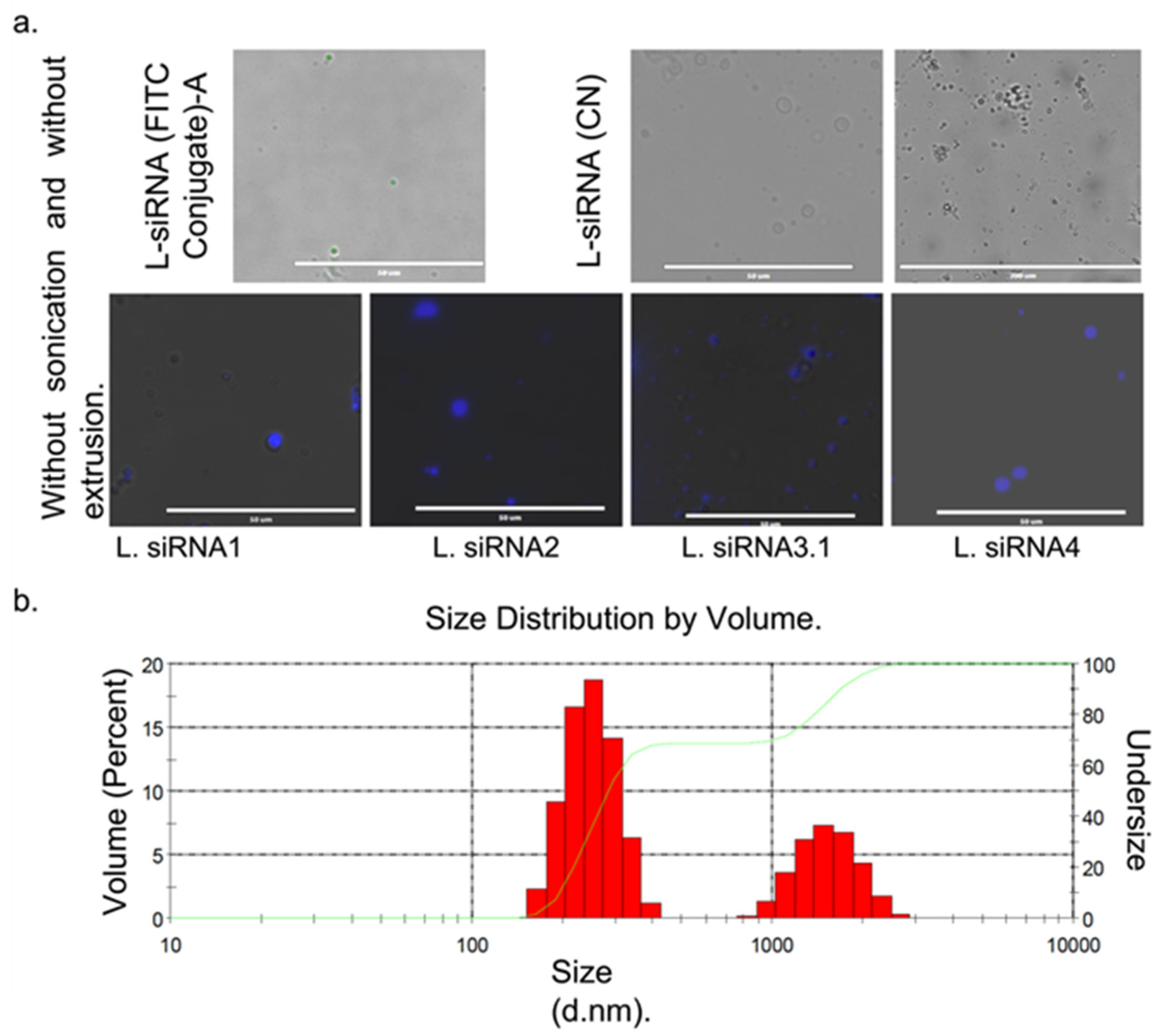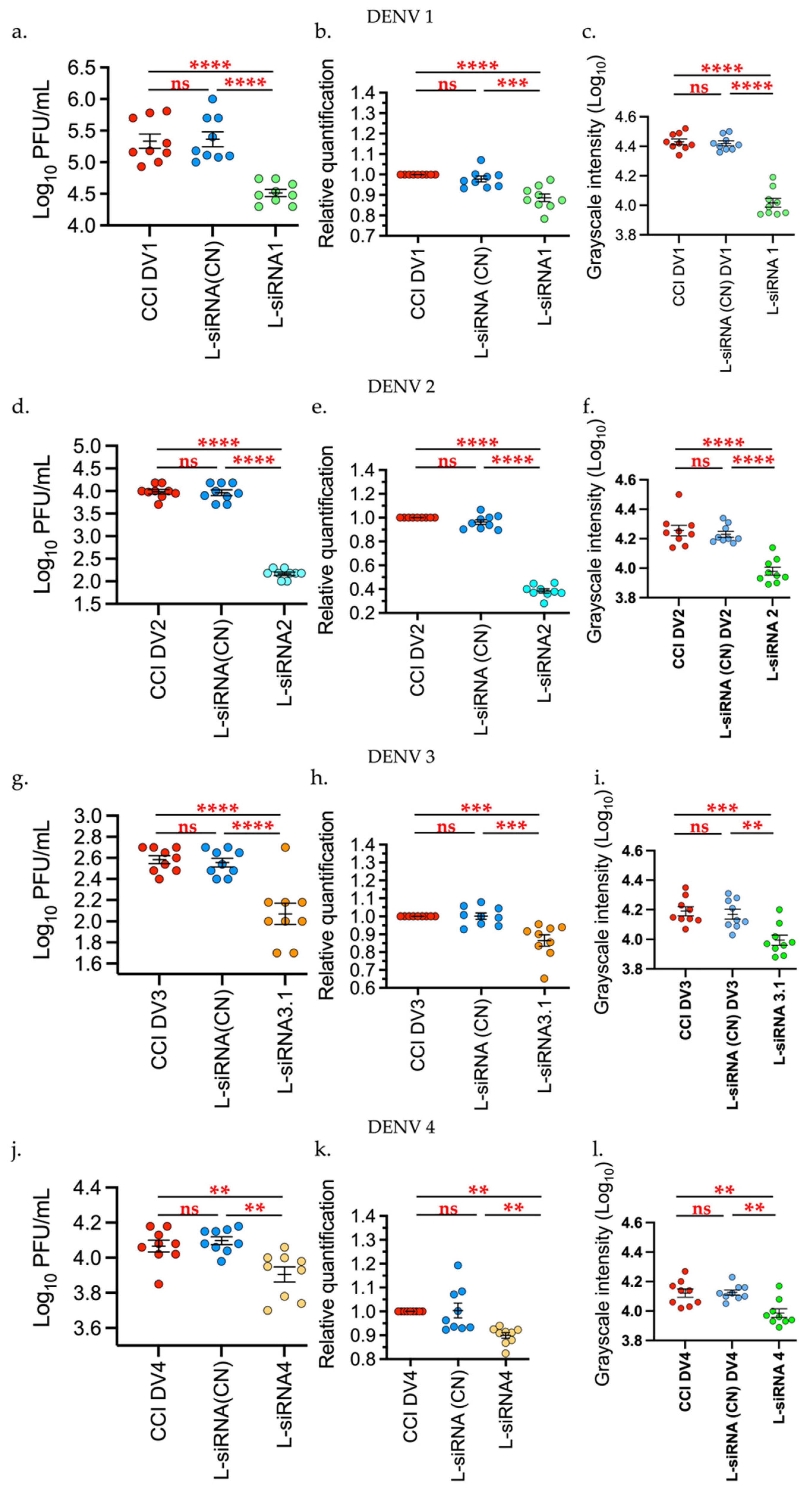In Vitro Inhibition of Replication of Dengue Virus Serotypes 1–4 by siRNAs Bound to Non-Toxic Liposomes
Abstract
1. Introduction
2. Materials and Methods
2.1. Cells and Viruses
2.2. Obtaining Small Interfering RNAs
2.3. Transfection of siRNA and Treatments with Liposomes-siRNA
Evaluation of Cell Viability
2.4. Plaque Assay
2.5. RT-qPCR
2.6. Formulation and Characterization of Liposomes-siRNA against DENV 1–4
2.7. Hemolysis Assay of Human Erythrocytes
2.8. Dot-Blot Type Immunoassay to Evaluate Interleukin Release (IL-1β, TNF-α, IFN-γ and IL-6) from Whole Blood and Production of NS1 Protein Post-Infection in HepG2 Cells
2.9. Statistical Analysis
3. Results
3.1. Selection of Sequences and Obtaining siRNA
3.2. Treatments with siRNA Show a Decrease in Viral Titers
3.3. The Liposomes-siRNA (L-siRNA) Structure and Concentration Does Not Affect Cell Viability, Not Produce Hemolysis and Stimulation of Interleukins (IL-1β. TNF-α. IFN-γ. and IL-6)
3.4. Liposomes-siRNA Inhibit the Viral Replication and Decrease NS1 Expression
4. Discussion
Supplementary Materials
Author Contributions
Funding
Informed Consent Statement
Conflicts of Interest
References
- Zonetti, L.F.C.; Coutinho, M.C.; de Araujo, A.S. Molecular Aspects of the Dengue Virus Infection Process: A Review. Protein Pept Lett. 2018, 25, 712–719. [Google Scholar] [CrossRef]
- Simmons, C.P.; Farrar, J.J.; Van Vinh Chau, N.; Wills, B. Current concepts: Dengue. N. Engl. J. Med. 2012, 366, 1423–1432. [Google Scholar] [CrossRef]
- Roopashri, G.; Vaishali, M.R.; David, M.P.; Baig, M.; Navneetham, A.; Venkataraghavan, K. Clinical and oral implications of dengue Fever: A review. J. Int. Oral Health JIOH 2015, 7, 69–73. [Google Scholar]
- Rodríguez-Salazar, C.A.; Recalde-Reyes, D.P.; González, M.M.; Padilla Sanabria, L.; Quintero-Álvarez, L.; Gallego-Gómez, J.C.; Castaño-Osorio, J.C. Manifestaciones clínicas y hallazgos de laboratorio de una serie de casos febriles agudos con diagnóstico presuntivo de infección por el virus dengue. Quindío Infectio. 2015, 20, 84–92. [Google Scholar] [CrossRef]
- Guo, C.; Zhou, Z.; Wen, Z.; Liu, Y.; Zeng, C.; Xiao, D.; Ou, M.; Han, Y.; Huang, S.; Liu, D.; et al. Global Epidemiology of Dengue Outbreaks in 1990–2015: A Systematic Review and Meta-Analysis. Front. Cell Infect Microbiol. 2017, 7, 1–11. [Google Scholar] [CrossRef]
- Harapan, H.; Michie, A.; Sasmono, R.T.; Imrie, A. Dengue: A Minireview. Viruses 2020, 12, 829. [Google Scholar] [CrossRef]
- Salles, T.S.; da Encarnação Sá-Guimarães, T.; de Alvarenga, E.S.L.; Guimarães-Ribeiro, V.; de Meneses, M.D.F.; de Castro-Salles, P.F.; dos Santos, C.R.; do Amaral Melo, A.C.; Soares, M.R.; Ferreira, D.F.; et al. History, epidemiology and diagnostics of dengue in the American and Brazilian contexts: A review. Parasit Vectors 2018, 11, 264–276. [Google Scholar] [CrossRef]
- Ruiz-López, F.; González-Mazo, A.; Vélez-Mira, A.; Gómez, G.F.; Zuleta, L.; Uribe, S.; Vélez-Bernal, I.D. Presencia de Aedes (Stegomyia) aegypti (Linnaeus, 1762) y su infección natural con el virus del dengue en alturas no registradas para Colombia. Biomédica 2016, 36, 303–308. [Google Scholar] [CrossRef]
- Holbrook, M. Historical Perspectives on Flavivirus Research. Viruses 2017, 9, 97. [Google Scholar] [CrossRef]
- Kroeger, A.; Nathan, M.B. Dengue: Setting the global research agenda. Lancet 2006, 368, 2193–2195. [Google Scholar] [CrossRef]
- Schmidt, A.G.; Lee, K.; Yang, P.L.; Harrison, S.C. Small-molecule inhibitors of dengue-virus entry. Pierson TC, editor. PLoS Pathog. 2012, 8, e1002627. [Google Scholar] [CrossRef]
- Otaka, A. Dengue Virus and Its Inhibitors: A Brief Review. Chem. Pharm. Bull. 2020, 68, 191–206. [Google Scholar]
- Prasad, M.; Ranjan, K.; Brar, B.; Shah, I.; Lalmbe, U.; Manimegalai, J.; Vashisht, B.; Gaury, M.; Kumar, P.; Khurana, S.K.; et al. Virus-Host Interactions: New Insights and Advances in Drug Development Against Viral Pathogens. Curr. Drug Metab. 2017, 18, 942–970. [Google Scholar] [CrossRef]
- Madhry, D.; Pandey, K.K.; Kaur, J.; Rawat, Y.; Sapra, L.; Kumar, R.Y.S.; Srivastava, R.K.; Bhattacharyya, S.; Verma, B. Role of non-coding RNAs in dengue virus-host interaction. Front. Biosci.-Sch. 2021, 13, 44–55. [Google Scholar]
- Qureshi, A.; Tantray, V.G.; Kirmani, A.R.; Ahangar, A.G. A review on current status of antiviral siRNA. Rev. Med. Virol. 2018, 28, 1–11. [Google Scholar] [CrossRef]
- Li, M.L.; Weng, K.F.; Shih, S.R.; Brewer, G. The evolving world of small RNAs from RNA viruses. Wiley Interdiscip Rev. RNA 2016, 7, 575–588. [Google Scholar] [CrossRef]
- Mcmillen, C.M.; Beezhold, D.H.; Blachere, F.M.; Othumpangat, S.; Kashon, M.L.; Noti, J.D. Inhibition of in fl uenza A virus matrix and nonstructural gene expression using RNA interference. Virology 2016, 497, 171–184. [Google Scholar] [CrossRef]
- Wang, F.; Chen, W.; Liu, P.; Zhou, J.; Liu, B.; Ye, W.; Wang, W.; Shen, X. Lentivirus-mediated RNAi knockdown of LMP2A inhibits the growth of the epstein-barr-associated gastric carcinoma cell line GT38 in vitro. Exp. Ther. Med. 2017, 13, 187–193. [Google Scholar] [CrossRef]
- Yuan, L.; Wu, R.; Liu, H.; Wen, X.; Huang, X.; Wen, Y.; Ma, X.; Yan, Q.; Huang, Y.; Zhao, Q.; et al. The NS3 and NS4A genes as the targets of RNA interference inhibit replication of Japanese encephalitis virus in vitro and in vivo. Gene 2016, 594, 183–189. [Google Scholar] [CrossRef]
- Saha, A.; Bhagyawant, S.S.; Parida, M.; Dash, P.K. Vector-delivered artificial miRNA effectively inhibited replication of Chikungunya virus. Antivir. Res. 2016, 134, 42–49. [Google Scholar] [CrossRef]
- Nakanishi, K. Anatomy of RISC: How do small RNAs and chaperones activate Argonaute proteins? Wiley Interdiscip Rev. RNA. 2016, 7, 637–660. [Google Scholar] [CrossRef]
- Takahashi, T.; Zenno, S.; Ishibashi, O.; Takizawa, T.; Saigo, K.; Ui-Tei, K. Interactions between the non-seed region of siRNA and RNA-binding RLC/RISC proteins, Ago and TRBP, in mammalian cells. Nucleic Acids Res. 2014, 42, 5256–5269. [Google Scholar] [CrossRef]
- Chen, S.; Tam, Y.Y.C.; Lin, P.J.C.; Sung, M.M.H.; Tam, Y.K.; Cullis, P.R. Influence of particle size on the in vivo potency of lipid nanoparticle formulations of siRNA. J. Control. Release 2016, 235, 236–244. [Google Scholar] [CrossRef]
- Cullis, P.R.; Hope, M.J. Lipid Nanoparticle Systems for Enabling Gene Therapies. Mol. Ther. 2017, 25, 1467–1475. [Google Scholar] [CrossRef]
- Inglut, C.T.; Sorrin, A.J.; Kuruppu, T.; Vig, S.; Cicalo, J.; Ahmad, H.; Huang, H.C. Immunological and toxicological considerations for the design of liposomes. Nanomater 2020, 10, 190. [Google Scholar] [CrossRef]
- Kumar, V.; Qin, J.; Jiang, Y.; Duncan, R.G.; Brigham, B.; Fishman, S.; Nair, J.K.; Akinc, A.; Barros, S.A.; Kasperkovitz, P.V. Shielding of Lipid Nanoparticles for siRNA Delivery: Impact on Physicochemical Properties, Cytokine Induction, and Efficacy. Mol. Ther - Nucleic Acids. 2014, 3, e210-7. [Google Scholar] [CrossRef]
- Hou, X.; Zaks, T.; Langer, R.; Dong, Y. Lipid nanoparticles for mRNA delivery. Nat. Rev. Mater. 2021, 2, e1–e17. [Google Scholar] [CrossRef]
- Aldosari, B.N.; Alfagih, I.M.; Almurshedi, A.S. Lipid nanoparticles as delivery systems for RNA-based vaccines. Pharmaceutics 2021, 13, 206. [Google Scholar] [CrossRef]
- Antimisiaris, S.; Mourtas, S.; Papadia, K. Targeted si-RNA with liposomes and exosomes (extracellular vesicles): How to unlock the potential. Int. J. Pharm. 2017, 525, 293–312. [Google Scholar] [CrossRef]
- Tatiparti, K.; Sau, S.; Kashaw, S.; Iyer, A. siRNA Delivery Strategies: A Comprehensive Review of Recent Developments. Nanomaterials 2017, 7, 77. [Google Scholar] [CrossRef]
- Swaminathan, G.; Thoryk, E.A.; Cox, K.S.; Smith, J.S.; Wolf, J.J.; Gindy, M.E.; Casimiro, D.R.; Bett, A.J. A Tetravalent Sub-unit Dengue Vaccine Formulated with Ionizable Cationic Lipid Nanoparticle induces Significant Immune Responses in Rodents and Non-Human Primates. Sci. Rep. 2016, 6, 34215–34232. [Google Scholar] [CrossRef]
- Naito, Y.; Yoshimura, J.; Morishita, S.; Ui-Tei, K. siDirect 2.0: Updated software for designing functional siRNA with reduced seed-dependent off-target effect. BMC Bioinform. 2009, 10, 392–400. [Google Scholar] [CrossRef]
- Ui-Tei, K.; Naito, Y.; Takahashi, F.; Haraguchi, T.; Ohki-Hamazaki, H.; Juni, A.; Ueda, R.; Saigo, K. Guidelines for the selection of highly effective siRNA sequences for mammalian and chick RNA interference. Nucleic Acids Res. 2004, 32, 936–948. [Google Scholar] [CrossRef]
- Reynolds, A.; Leake, D.; Boese, Q.; Scaringe, S.; Marshall, W.S.; Khvorova, A. Rational siRNA design for RNA interference. Nat. Biotechnol. 2004, 22, 326–330. [Google Scholar] [CrossRef]
- Amarzguioui, M.; Prydz, H. An algorithm for selection of functional siRNA sequences. Biochem. Biophys. Res. Commun. 2004, 316, 1050–1058. [Google Scholar] [CrossRef]
- Kibbe, W.A. OligoCalc: An online oligonucleotide properties calculator. Nucleic Acids Res. 2007, 35, 43–46. [Google Scholar] [CrossRef]
- Feoktistova, M.; Geserick, P.; Leverkus, M. Crystal violet assay for determining viability of cultured cells. Cold Spring Harb Protoc. 2016, 2016, 343–346. [Google Scholar] [CrossRef]
- Giraldo, M.I.; Xia, H.; Aguilera-aguirre, L.; Hage, A.; Van, S.; Shan, C.; Xie, X.; Sturdevant, G.L.; Robertson, S.J.; Kristin, L.; et al. Envelope Protein Ubiquitination Drives Entry and Pathogenesis of Zika Virus. Nature 2020, 585, 414–419. [Google Scholar] [CrossRef]
- Schindelin, J.; Arganda-Carreras, I.; Frise, E.; Kaynig, V.; Longair, M.; Pietzsch, T.; Preibisch, S.; Rueden, C.; Saalfeld, S.; Schmid, B.; et al. Fiji: An open-source platform for biological-image analysis. Nat. Methods 2012, 9, 676–682. [Google Scholar] [CrossRef]
- Durhuus, J.A.; Rozing, M.P.; Nielsen, M.K.; Molbech, C.R.; Keijzers, G.; Scheibye-Knudsen, M.; Rasmussen, L.J.; Westendorp, R.G.J.; Sørensen, T.L. EX-vivo whole blood stimulation with A2E does not elicit an inflammatory cytokine response in patients with age-related macular degeneration. Sci. Rep. 2021, 11, 8226–8234. [Google Scholar] [CrossRef]
- Wong, R.R.; Abd-Aziz, N.; Affendi, S.; Poh, C.L. Role of microRNAs in antiviral responses to dengue infection. J. Biomed Sci. 2020, 27, 4–15. [Google Scholar] [CrossRef]
- Idrees, S.; Ashfaq, U.A. RNAi: Antiviral therapy against dengue virus. Asian Pac. J. Trop Biomed. 2013, 3, 232–236. [Google Scholar] [CrossRef]
- Kakumani, P.K.; Ponia, S.S.; Rajgokul, K.S.; Sood, V.; Chinnappan, M.; Banerjea, A.C.; Medigeshi, G.R.; Malhotra, P.; Mukherjee, S.K.; Bhatnagar, R.K. Role of RNA Interference (RNAi) in Dengue Virus Replication and Identification of NS4B as an RNAi Suppressor. J. Virol. 2013, 87, 8870–8883. [Google Scholar] [CrossRef]
- de Borba, L.; Villordo, S.M.; Marsico, F.L.; Carballeda, J.M.; Filomatori, C.V.; Gebhard, L.G.; Pallarés, H.M.; Lequime, S.; Lambrechts, L.; Sánchez Vargas, I.; et al. RNA Structure Duplication in the Dengue Virus 3′ UTR: Redundancy or Host Specificity? Coyne CB, editor. MBio 2019, 10, e02506-18. [Google Scholar] [CrossRef]
- Sharif Shohan, M.U.; Paul, A.; Hossain, M. Computational design of potential siRNA molecules for silencing nucleoprotein gene of rabies virus. Future Virol. 2018, 13, 159–170. [Google Scholar] [CrossRef]
- Kamola, P.J.; Nakano, Y.; Takahashi, T.; Wilson, P.A.; Ui-Tei, K. The siRNA Non-seed Region and Its Target Sequences Are Auxiliary Determinants of Off-Target Effects. PLoS Comput Biol. 2015, 11, 1–17. [Google Scholar] [CrossRef]
- Shiryaev, V.A.; Radchenko, E.V.; Palyulin, V.A.; Zefirov, N.S.; Bormotov, N.I.; Serova, O.A.; Shishkina, L.N.; Baimuratov, M.R.; Bormasheva, K.M.; Gruzd, Y.A.; et al. Molecular design, synthesis and biological evaluation of cage compound-based inhibitors of hepatitis C virus p7 ion channels. Eur. J. Med. Chem. 2018, 158, 214–235. [Google Scholar] [CrossRef]
- Nakamura, T.; Kuroi, M.; Fujiwara, Y.; Warashina, S.; Sato, Y.; Harashima, H. Small-sized, stable lipid nanoparticle for the efficient delivery of siRNA to human immune cell lines. Sci. Rep. 2016, 6, 37849–37858. [Google Scholar] [CrossRef]
- Paul, A.M.; Shi, Y.; Acharya, D.; Douglas, J.R.; Cooley, A.; Anderson, J.F.; Huang, F.; Bai, F. Delivery of antiviral small interfering RNA with gold nanoparticles inhibits dengue virus infection in vitro. J. Gen. Virol. 2014, 95, 1712–1722. [Google Scholar] [CrossRef]
- Wittrup, A.; Lieberman, J. Knocking down disease: A progress report on siRNA therapeutics. Nat. Rev. Genet. 2015, 16, 543–552. [Google Scholar] [CrossRef]
- Lowey, B.; Li, Q. Hepatitis C Virus Infection of Cultured Cells and Primary Human Hepatocytes. Curr. Protoc. Cell Biol. 2018, 80, e54–e68. [Google Scholar] [CrossRef]
- Subramanya, S.; Kim, S.-S.; Abraham, S.; Yao, J.; Kumar, M.; Kumar, P.; Haridas, V.; Lee, S.-K.; Shultz, L.D.; Greiner, D.; et al. Targeted delivery of small interfering RNA to human dendritic cells to suppress dengue virus infection and associated proinflammatory cytokine production. J. Virol. 2010, 84, 2490–2501. [Google Scholar] [CrossRef]
- Saw, P.E.; Song, E.W. siRNA therapeutics: A clinical reality. Sci. China Life Sci. 2020, 63, 485–500. [Google Scholar] [CrossRef]
- Fan, Y.; Marioli, M.; Zhang, K. Analytical characterization of liposomes and other lipid nanoparticles for drug delivery. J. Pharm. Biomed Anal. 2021, 192, 113642–113659. [Google Scholar] [CrossRef]
- Jayaraman, M.; Ansell, S.M.; Mui, B.L.; Tam, Y.K.; Chen, J.; Du, X.; Butler, D.; Eltepu, L.; Matsuda, S.; Narayanannair, J.K.; et al. Maximizing the potency of siRNA lipid nanoparticles for hepatic gene silencing in vivo. Angew. Chemie - Int. Ed. 2012, 51, 8529–8533. [Google Scholar] [CrossRef]
- Morrissey, D.V.; Lockridge, J.A.; Shaw, L.; Blanchard, K.; Jensen, K.; Breen, W.; Hartsough, K.; Machemer, L.; Radka, S.; Jadhav, V.; et al. Potent and persistent in vivo anti-HBV activity of chemically modified siRNAs. Nat. Biotechnol. 2005, 23, 1002–1007. [Google Scholar] [CrossRef]
- Olusanya, T.O.B.; Ahmad, R.R.H.; Ibegbu, D.M.; Smith, J.R.; Elkordy, A.A. Liposomal drug delivery systems and anticancer drugs. Molecules 2018, 23, 907. [Google Scholar] [CrossRef]
- Wang, Z.; Ren, L.; Zhao, X.; Hung, T.; Meng, A.; Wang, J.; Chen, Y.-G. Inhibition of Severe Acute Respiratory Syndrome Virus Replication by Small Interfering RNAs in Mammalian Cells. J. Virol. 2004, 78, 7523–7527. [Google Scholar] [CrossRef]
- Földes, F.; Madai, M.; Papp, H.; Kemenesi, G.; Zana, B.; Geiger, L.; Gombos, K.; Somogyi, B.; Bock-Marquette, I.; Jakab, F. Small interfering RNAs are highly effective inhibitors of Crimean-Congo hemorrhagic fever virus replication in vitro. Molecules 2020, 25, 5771. [Google Scholar] [CrossRef]
- Ye, C.; Abraham, S.; Wu, H.; Shankar, P.; Manjunath, N. Silencing early viral replication in macrophages and dendritic cells effectively suppresses flavivirus encephalitis. PLoS ONE 2011, 6, e17889 1-7. [Google Scholar] [CrossRef][Green Version]
- Liu, C.; Liang, Z.; Kong, X. Efficacy analysis of combinatorial siRNAs against HIV derived from one double hairpin RNA precursor. Front. Microbiol. 2017, 8, 1–10. [Google Scholar] [CrossRef] [PubMed]
- Williams, A.E.; Sanchez-Vargas, I.; Reid, W.R.; Lin, J.; Franz, A.W.E.; Olson, K.E. The Antiviral Small-Interfering RNA Pathway Induces Zika Virus Resistance in Transgenic Aedes aegypti. Viruses 2020, 12, 1231. [Google Scholar] [CrossRef] [PubMed]
- Chen, S.; Tam, Y.Y.C.; Lin, P.J.C.; Leung, A.K.K.; Tam, Y.K.; Cullis, P.R. Development of lipid nanoparticle formulations of siRNA for hepatocyte gene silencing following subcutaneous administration. J. Control. Release 2014, 196, 106–112. [Google Scholar] [CrossRef] [PubMed]
- Kulkarni, J.A.; Myhre, J.L.; Chen, S.; Tam, Y.Y.C.; Danescu, A.; Richman, J.M.; Cullis, P.R. Design of lipid nanoparticles for in vitro and in vivo delivery of plasmid DNA. Nanomed. Nanotechnol. Biol. Med. 2017, 13, 1377–1387. [Google Scholar] [CrossRef]
- Evers, M.J.W.; Kulkarni, J.A.; van der Meel, R.; Cullis, P.R.; Vader, P.; Schiffelers, R.M. Design and Rapid-Mixing Production Techniques of Lipid Nanoparticles for Nucleic Acid Delivery. Small Methods. 2018, 2, 1–20. [Google Scholar] [CrossRef]
- Zhi, D.; Bai, Y.; Yang, J.; Cui, S.; Zhao, Y.; Chen, H.; Zhang, S. A review on cationic lipids with different linkers for gene delivery. Adv. Colloid Interface Sci. 2018, 253, 117–140. [Google Scholar] [CrossRef]
- Kachare, D.S.; Pawar, R.K.; Ghadge, P.K.; Mali, S.S. Liposome as carrier for cancer treatment: A review. Eur. J. Pharm. Med. Res. 2020, 7, 1–10. [Google Scholar]
- Bozzuto, G.; Molinari, A. Liposomes as nanomedical devices. Int. J. Nanomed. 2015, 10, 975–999. [Google Scholar] [CrossRef]
- Shiraishi, K.; Yokoyama, M. Toxicity and immunogenicity concerns related to PEGylated-micelle carrier systems: A review. Sci. Technol. Adv. Mater. 2019, 20, 324–336. [Google Scholar] [CrossRef]
- Maugeri, M.; Nawaz, M.; Papadimitriou, A.; Angerfors, A.; Camponeschi, A.; Na, M.; Hölttä, M.; Skantze, P.; Johansson, S.; Sundqvist, M.; et al. Linkage between endosomal escape of LNP-mRNA and loading into EVs for transport to other cells. Nat. Commun. 2019, 10, 4333–4349. [Google Scholar] [CrossRef]




| Name | Sequence | Target Protein Position | %GC | * BFE | ** FBE | Predicted Inhibition Efficiency |
|---|---|---|---|---|---|---|
| DV1-siRNA 1.1 | 5′CACUGCAUGGGACUUUGGUUCUAUA 3′ 5′ UAUAGAACCAAAGUCCCAUGCAGUG 3′ | E | 44 | 2.1 | −45.7 | 1.006 |
| DV1-siRNA 1.2 | 5′ GAGCAUGGAACAUUUGGGAAGUUGA 3′ 5′ UCAACUUCCCAAAUGUUCCAUGCUC 3′ | NS1 | 44 | 2.1 | −45.1 | 1.014 |
| DV1-siRNA 2.1 | 5′ CCUCCAUUUGGAGACAGCUACAUCA 3′ 5′ UGAUGUAGCUGUCUCCAAAUGGAGG 3′ | E | 48 | −5.2 | −48 | 0.947 |
| DV1-siRNA 2.2 | 5′ CCUGGGAGGAGUGUUCACAUCUAUA 3′ 5′ UAUAGAUGUGAACACUCCUCCCAGG 3′ | E | 48 | 1.9 | −48.4 | 1.021 |
| DV1-siRNA 3.1 | 5′ CCUGGAACAAGAAAGAGCUUCUUGU 3′ 5′ ACAAGAAGCUCUUUCUUGUUCCAGG 3′ | E | 44 | −5.0 | −44.9 | 0.975 |
| DV1-siRNA 3.2 | 5′ GAGCAAACAGGAGUGUCCCACAAUU 3′ 5′ AAUUGUGGGACACUCCUGUUUGCUC 3′ | NS2B | 48 | −3.1 | −46.3 | 1.004 |
| DV1-siRNA 4.1 | 5′ CCACAUUCAGGAAUGGGAUUGGAAA 3′ 5′ UUUCCAAUCCCAUUCCUGAAUGUGG 3′ | PreM | 44 | −2.5 | −45.1 | 0.971 |
| DV1-siRNA 4.2 | 5′ CAGAAGCAAAGAUGCUGCUUGACAA 3′ 5′ UUGUCAAGCAGCAUCUUUGCUUCUG 3′ | NS3 | 44 | −4.7 | −44.8 | 0.975 |
| DV1-siRNA 1 | 5′ UGUUAGAACUACGUUAAGCAA 3′ 5′ GCUUAACGUAGUUCUAACAGU 3′ | C | 36 | 1.7 | −31.7 | 1.02 |
| DV1-siRNA 2 | 5′ UGAUUAUGCAGCACAUUCCCA 3′ 5′ GGAAUGUGCUGCAUAAUCACG 3′ | NS4A | 45 | −1.3 | −37 | 0.996 |
| DV1-siRNA 3 | 5′ UCUUUUCAACCCUUCUUUGGC 3′ 5′ CAAAGAAGGGUUGAAAAGAGG 3′ | NS5 | 43 | 1.8 | −35.7 | 0.94 |
| DV1-siRNA 4 | 5′ UUUUUUGAGCUCUCUAUCCAA 3′ 5′ GGAUAGAGAGCUCAAAAAACC 3′ | NS1 | 38 | 1.8 | −32.2 | 1.019 |
Publisher’s Note: MDPI stays neutral with regard to jurisdictional claims in published maps and institutional affiliations. |
© 2022 by the authors. Licensee MDPI, Basel, Switzerland. This article is an open access article distributed under the terms and conditions of the Creative Commons Attribution (CC BY) license (https://creativecommons.org/licenses/by/4.0/).
Share and Cite
Rodriguez-Salazar, C.A.; Recalde-Reyes, D.P.; Bedoya, J.P.; Padilla-Sanabria, L.; Castaño-Osorio, J.C.; Giraldo, M.I. In Vitro Inhibition of Replication of Dengue Virus Serotypes 1–4 by siRNAs Bound to Non-Toxic Liposomes. Viruses 2022, 14, 339. https://doi.org/10.3390/v14020339
Rodriguez-Salazar CA, Recalde-Reyes DP, Bedoya JP, Padilla-Sanabria L, Castaño-Osorio JC, Giraldo MI. In Vitro Inhibition of Replication of Dengue Virus Serotypes 1–4 by siRNAs Bound to Non-Toxic Liposomes. Viruses. 2022; 14(2):339. https://doi.org/10.3390/v14020339
Chicago/Turabian StyleRodriguez-Salazar, Carlos Andrés, Delia Piedad Recalde-Reyes, Juan Pablo Bedoya, Leonardo Padilla-Sanabria, Jhon Carlos Castaño-Osorio, and Maria Isabel Giraldo. 2022. "In Vitro Inhibition of Replication of Dengue Virus Serotypes 1–4 by siRNAs Bound to Non-Toxic Liposomes" Viruses 14, no. 2: 339. https://doi.org/10.3390/v14020339
APA StyleRodriguez-Salazar, C. A., Recalde-Reyes, D. P., Bedoya, J. P., Padilla-Sanabria, L., Castaño-Osorio, J. C., & Giraldo, M. I. (2022). In Vitro Inhibition of Replication of Dengue Virus Serotypes 1–4 by siRNAs Bound to Non-Toxic Liposomes. Viruses, 14(2), 339. https://doi.org/10.3390/v14020339






